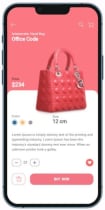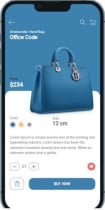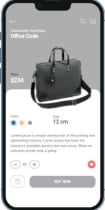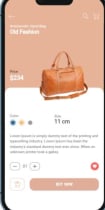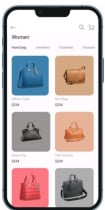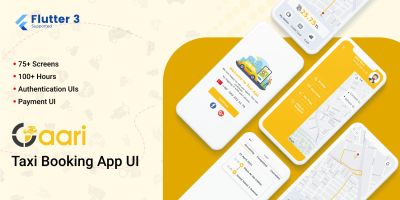Flutter ui E-commerce App Products & DetailsFlutter ui E-commerce App Products & Details
Flutter UI E-commerce App provides a seamless and visually appealing interface for users to browse and shop for products. ..Flutter ui E-commerce App Products & Details
Flutter UI E-commerce App provides a seamless and visually appealing interface for users to brows...
Overview
Flutter UI E-commerce App provides a seamless and visually appealing interface for users to browse and shop for products. The app is designed with a modern and intuitive layout, ensuring that users can easily navigate through various categories and discover new items. The product listings are displayed with high-quality images, brief descriptions, and pricing information, making it convenient for users to quickly assess and compare different options. The use of Flutter ensures a smooth and responsive experience across both iOS and Android devices, enhancing user satisfaction.
In addition to product browsing, the app offers detailed product pages where users can find comprehensive information about each item. These pages include detailed descriptions, multiple images, customer reviews, and specifications, providing users with all the necessary information to make informed purchasing decisions. The integration of interactive elements such as image sliders and zoom functionality further enriches the user experience. With its sleek design and user-friendly features, the Flutter UI E-commerce App is crafted to boost user engagement and drive sales effectively.
Features
- User-Friendly Interface: A clean and modern design that makes navigation intuitive and enjoyable for users, ensuring a seamless shopping experience.
- Cross-Platform Compatibility: Built with Flutter, the app provides a consistent and smooth experience on both iOS and Android devices.
- Product Listings: High-quality images, brief descriptions, and pricing information are displayed for each product, making it easy for users to browse and compare options.
- Detailed Product Pages: Comprehensive information about each product, including detailed descriptions, multiple images, customer reviews, and specifications, helps users make informed decisions.
- Interactive Elements: Features such as image sliders and zoom functionality enhance user engagement and allow for a closer look at the products.
- Search and Filter Options: Advanced search and filter capabilities enable users to quickly find products based on their preferences and criteria.
- Shopping Cart: A convenient shopping cart feature that allows users to add, remove, and manage items before proceeding to checkout.
- Secure Checkout: Integration with secure payment gateways ensures that users can complete their purchases safely and efficiently.
- Order Tracking: Users can track their orders in real-time, from purchase to delivery, providing transparency and peace of mind.
- User Accounts: Personal accounts where users can view order history, save favorite items, and manage their profile information.
- Push Notifications: Timely notifications about special offers, new arrivals, and order updates keep users informed and engaged.
- Customer Support: Easy access to customer service through in-app messaging or contact forms ensures that users can get assistance whenever needed.
Requirements
Technical Requirements:
- Development Environment:
- Flutter SDK
- Dart programming language
- Integrated Development Environment (IDE) such as Android Studio or Visual Studio Code
- Backend:
- A robust backend server (Node.js, Django, etc.) to handle user authentication, product management, and order processing
- Database (e.g., Firebase, MongoDB, MySQL) for storing user data, product information, and order details
- RESTful API or GraphQL for seamless communication between the app and the backend
- Third-Party Integrations:
- Payment gateways (e.g., Stripe, PayPal) for secure transactions
- Push notification service (e.g., Firebase Cloud Messaging)
- Analytics tools (e.g., Google Analytics, Firebase Analytics) to track user behavior and app performance
- Version Control:
- Git for source code management and version control
- Hosting:
- Cloud services (e.g., AWS, Google Cloud, Azure) for hosting the backend server and database
Functional Requirements:
- User Authentication:
- User registration and login functionality using email, social media accounts, or phone number
- Product Management:
- Admin panel for adding, updating, and deleting products
- Categorization and tagging of products for easy browsing
- Order Management:
- Functionality to manage shopping carts, order placement, and order history
- Real-time order tracking for users
- Search and Filters:
- Advanced search functionality with filters based on categories, price range, ratings, etc.
- User Profile:
- User account management features including profile updates, viewing order history, and saving favorite products
- Notifications:
- Implementation of push notifications for order updates, promotions, and new product arrivals
- Security:
- Implementation of security measures such as data encryption, secure user authentication, and protection against SQL injection and other vulnerabilities
- Testing:
- Automated testing using tools like Flutter's testing framework for unit and integration tests
By meeting these technical and functional requirements, the Flutter UI E-commerce App can deliver a high-quality, secure, and user-friendly shopping experience.
Instructions
Instructions for Setting Up the Flutter UI E-commerce App
Prerequisites:
- Development Environment:
- Install Flutter SDK from the official Flutter website.
- Install Dart SDK (usually comes bundled with Flutter).
- Install an IDE like Android Studio or Visual Studio Code.
- Version Control:
- Install Git for version control from the official Git website.
- Backend Setup:
- Choose a backend framework (e.g., Node.js, Django) and set up the development environment accordingly.
- Set up a database (e.g., Firebase, MongoDB, MySQL).
Steps to Set Up the App:
- Clone the Repository:
- Clone the app's repository using Git:
- Open a terminal and run
git clone <repository-url>. - Navigate to the cloned directory with
cd <repository-directory>.
- Open a terminal and run
- Clone the app's repository using Git:
- Install Dependencies:
- Navigate to the app's directory in your terminal.
- Run
flutter pub getto install the necessary dependencies.
- Configure the Backend:
- Set up your backend server and database.
- Ensure the backend is running and accessible.
- Update the API endpoints in the Flutter app to match your backend configuration.
- Set Up Environment Variables:
- Create a
.envfile in the root of your project (if applicable). - Add necessary environment variables such as API keys, database URLs, etc.
- Create a
- Configure Payment Gateways:
- Set up accounts with the chosen payment gateways (e.g., Stripe, PayPal).
- Configure the payment gateway credentials in the app's settings.
- Set Up Push Notifications:
- Configure Firebase Cloud Messaging (FCM) for push notifications.
- Update the app with your FCM credentials.
- Run the App:
- Connect a physical device or start an emulator.
- Run the app using the command
flutter runin your terminal.
- Testing:
- Run automated tests if available using the command
flutter test.
- Run automated tests if available using the command
- Deployment:
- For Android: Generate a signed APK or app bundle for release by running
flutter build apk --release. - For iOS: Follow the official guide on the Flutter website to prepare the app for the App Store.
- For Android: Generate a signed APK or app bundle for release by running
- Monitor and Maintain:
- Use analytics tools to monitor user behavior and app performance.
- Regularly update the app to fix bugs, add new features, and improve performance.
Other items by this author
| Category | App Templates / Flutter / UI Kits |
| First release | 30 June 2024 |
| Last update | 30 June 2024 |
| Operating Systems | iOS 10.0, Android 7.0, Android 8.0, iOS 11.0, Android 9.0, iOS 12.0, iOS 8.0, iOS 9.0, Android 5.0, Android 6.0 |
| Files included | .css, .html, Layered .png, .java |
| Tags | push notifications, shopping cart, customer support, user-friendly interface, product listings, order tracking, user accounts, cross-platform compatibility, detailed product pages, interactive elements, search and filter options, secure checkout |


